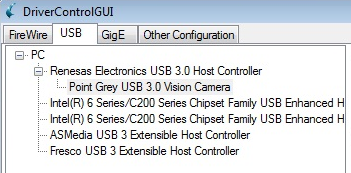Using USB3 Vision Cameras with A&B Software’s ActiveUSB
This application note provides information on how to configure and use USB3 Vision cameras. This document helps users understand the basics of USB3 Vision, and how to use USB3 Vision cameras with third-party USB3 Vision software.
Preparing for Use
Before you use your camera, we recommend that you are aware of the following resources:
Getting Started Manual for the camera—provides information on installing components and software needed to run the camera.
Technical Reference for the camera—provides information on the camera’s specifications, features and operations, as well as imaging and acquisition controls. The technical references can be downloaded from the Downloads page.
Firmware updates—ensure you are using to most up-to-date firmware for the camera to take advantage of improvements and fixes. The latest firmware can be downloaded from the Downloads page.
Understanding USB3 Vision
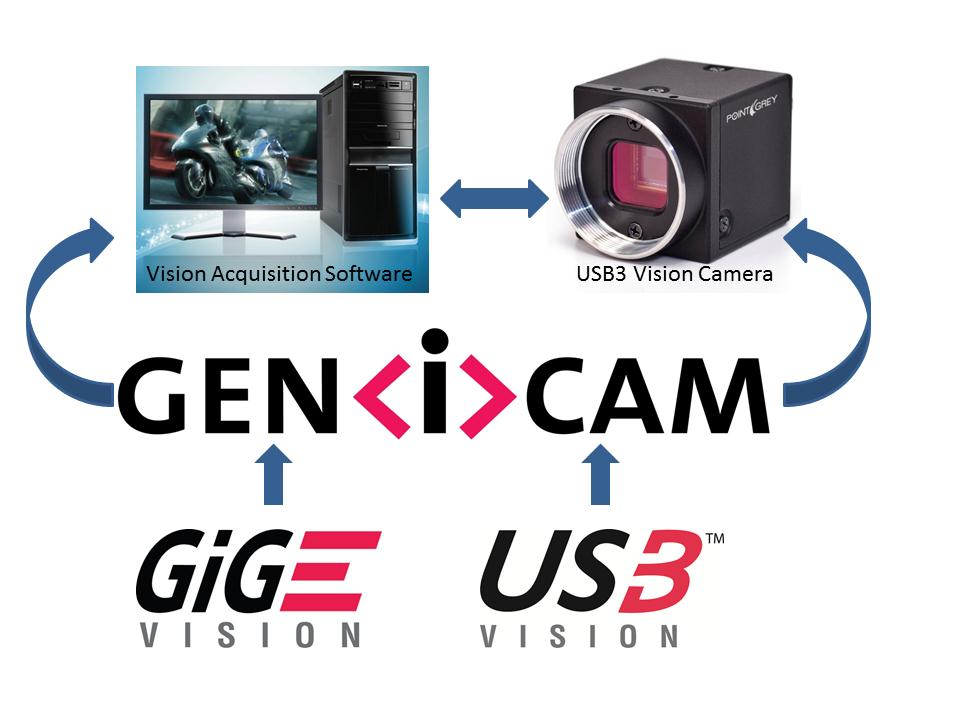
USB3 Vision is a communication interface for vision applications based on the USB 3.1 technology. All cameras supporting USB3 Vision interact the same way with software also supporting USB3 Vision.
The USB3 Vision standard defines required elements for camera identification, control, and output. Like GigE Vision, it uses GenICam, a programming interface for camera attribute control. GenICam allows camera vendors to define features and attributes in an XML file stored inside the camera. The file is parsed by the host application when the camera is initially discovered. One of the key benefits of GenICam is the ability for camera vendors to introduce new camera-specific features without needing to update the host application.
Each camera attribute, such as exposure time, is controlled by a specific GenICam feature. Most USB3 Vision applications provide a Graphical User Interface (GUI) to control these attributes.
For more information on the USB3 Vision standard, visit visiononline.org.
For more information on GenICam, visit emva.org.
Installation and Configuration
System Requirements
- USB 3.1 interface card
- Teledyne FLIR machine vision USB 3.1 camera with USB3 Vision firmware
- FlyCapture 2.5 or later
- USB3 Vision compliant software—the example used in this document is A&B Software’s ActiveUSB demo application
Before using a camera with a third-party application, complete the following steps:
1. Install FlyCapture 2.5 (or later).
2. Install the third-party USB3 Vision software.
3. Plug in the USB3 Vision camera to the USB 3.1 host controller.
4. Verify the camera’s firmware and update it if necessary.
5. Verify the USB 3.1 host controller is using the manufacturer’s driver.
6. Install the third-party USB 3.1 camera driver.
The following sections provide more detail.
Step 1—Install FlyCapture 2.5 (or later)
The FlyCapture 2.5 SDK contains tools that allow you to verify and update the camera firmware, install and configure camera drivers, and test camera operation.
If you already have FlyCapture 2.5 installed, proceed to Step 2.
Step 2—Install Third-Party USB3 Vision Software
The example used in this document is A&B Software’s ActiveUSB demo application. A&B Software contains the required USB3 Vision camera driver and the user interface for controlling camera attributes.
Step 3—Connect the Camera
Using a USB 3.1 cable, connect the camera to the USB 3.1 host controller on the PC.
Step 4—Verify Firmware and Update if Necessary
USB3 Vision support for Teledyne FLIR USB 3.1 cameras started from the following firmware version:
| Camera | Firmware |
| Blackfly S USB 3.1 | All versions - no update required |
| Blackfly USB 3.1 | All versions - no update required |
| Flea3 USB 3.1 | 2.7.3.3 and newer |
| Grasshopper3 USB 3.1 | 2.3.3.0 and newer |
To determine your camera’s firmware version:
1. Ensure the camera has powered up.
2. Open the FlyCap2 program, installed with the FlyCapture2 SDK.
Start menu→All Programs→Point Grey FlyCapture2 SDK→Point Grey FlyCap2
The firmware version is displayed in the Camera Selection window, as well as on the Camera Information tab of the Camera Control dialog.
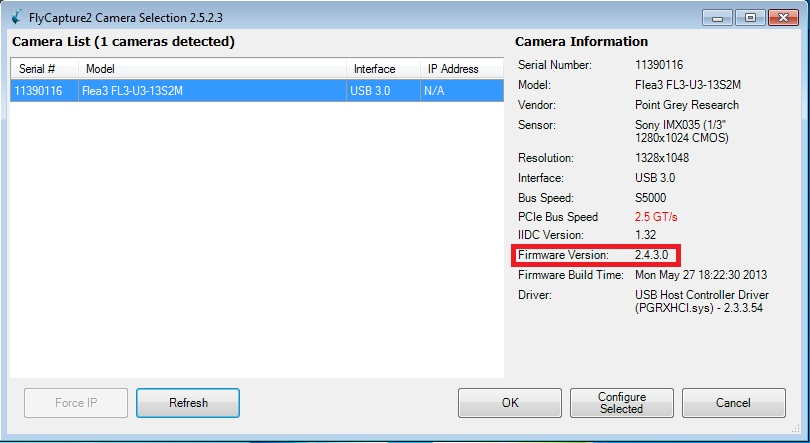
FlyCap2 Camera Selection Window
If the firmware of the camera supports USB3 Vision, proceed to Step 5.
If the firmware of the camera does not support USB3 Vision, you can update the firmware to the latest version.
To update your camera’s firmware version:
1. Download the firmware file from the Downloads page.
2. Ensure the camera has powered up.
3. Open the UpdatorGUI utility, installed with FlyCapture2 SDK.
Start menu→All Programs→Point Grey FlyCapture2 SDK→Utilities→UpdatorGUI3
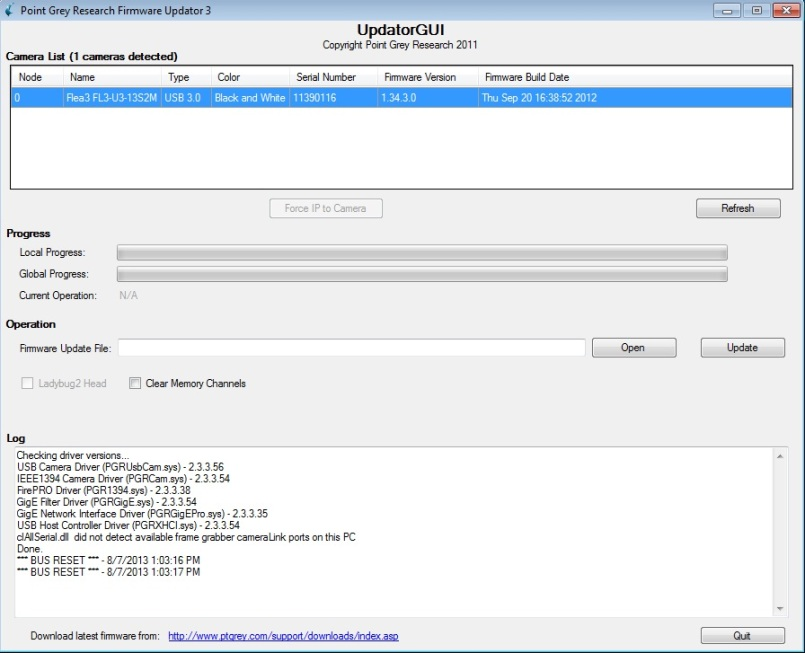
4. Select the camera from the Camera List
5. Click Open to select the firmware file.
6. Click Update to begin the update process. Do NOT disconnect the camera until the update is complete.
Step 5—Verify the USB 3.1 Host Controller Driver
Third-party USB3 Vision applications come with their own device driver, which needs to be installed for the USB3 Vision camera. To install the third-party device driver for the USB3 Vision camera, the USB 3.1 host controller must be configured to use the manufacturer’s driver, and not the USBPro driver (pgrxhci). If using Windows 8, the Windows driver can also be used.
|
|
If the USB 3.1 host controller is configured to use the USBPro driver you are not able to install the third-party camera driver. |
To determine which driver the USB 3.1 host controller is using, open DriverControlGUI and click on the USB tab.
Start menu→All Programs→Point Grey FlyCapture2 SDK→Utilities→DriverControlGUI
If the host controller is configured for the Point Grey USBPro driver, the camera does not appear as a separate device.
In the figures to the right: A. Shows a Renesas USB 3 Extensible Host Controller with the Point Grey USBPro driver installed. The camera is not shown.
|
|
|
B. Shows a Flea3 camera as a separate device listing running with a Renesas USB 3.1 Host Controller with the manufacturer’s driver installed. The camera and card are listed as two separate devices. |
|
If your USB 3.1 host controller is using the manufacturer’s driver (or the Windows 8 driver), then proceed to Step 6.
If your USB 3.1 host controller is using the Point Grey USBPro driver, you can change this using the DriverControlGUI.
To change the driver of the USB 3.1 host controller:
1. Ensure the camera has powered up.
2. Open the DriverControlGUI utility, installed with the FlyCapture2 SDK.
Start menu→All Programs→Point Grey FlyCapture2 SDK→Utilities→DriverControlGUI
3. Click on the USB tab.
4. From the PC tree, select the host controller.
5. Under Driver Selection, select Third-Party Drivers, and select the driver from the drop-down. If there is more than one listed, select the latest version for the manufacturer.
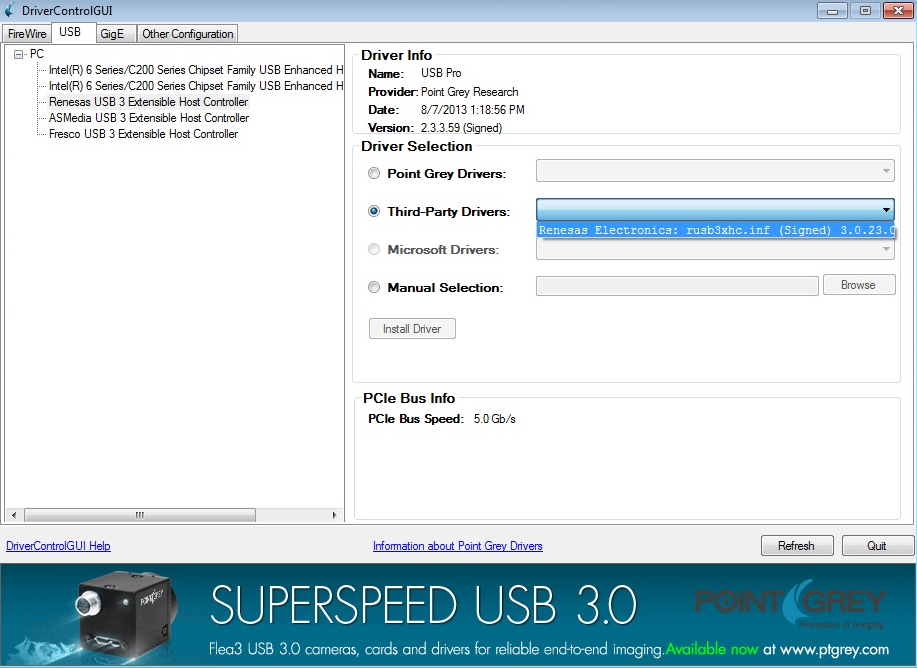
6. If no driver is listed, select Manual Selection and click Browse to find the driver on your computer.
7. Click Install Driver.
Step 6—Install Third-Party Driver on the Camera
In order to have the third-party driver, you must have installed the third-party software in Step 2.
To install the third-party USB3 Vision driver on the camera:
1. Ensure the camera has powered up.
2. Open the DriverControlGUI utility, installed with the FlyCapture2 SDK.
Start menu→All Programs→Point Grey FlyCapture2 SDK→UtilitiesàDriverControlGUI
3. Click on the USB tab.
4. From the PC tree, under the host controller, select the Point Grey USB 3.1 Vision Camera.
5. Under Driver Selection, select manual selection, and browse to find the driver on your computer
For A&B Software, the 64 bit driver is:
C:\Program Files\ActiveUSB\Driver\Win64\usb3vision.inf
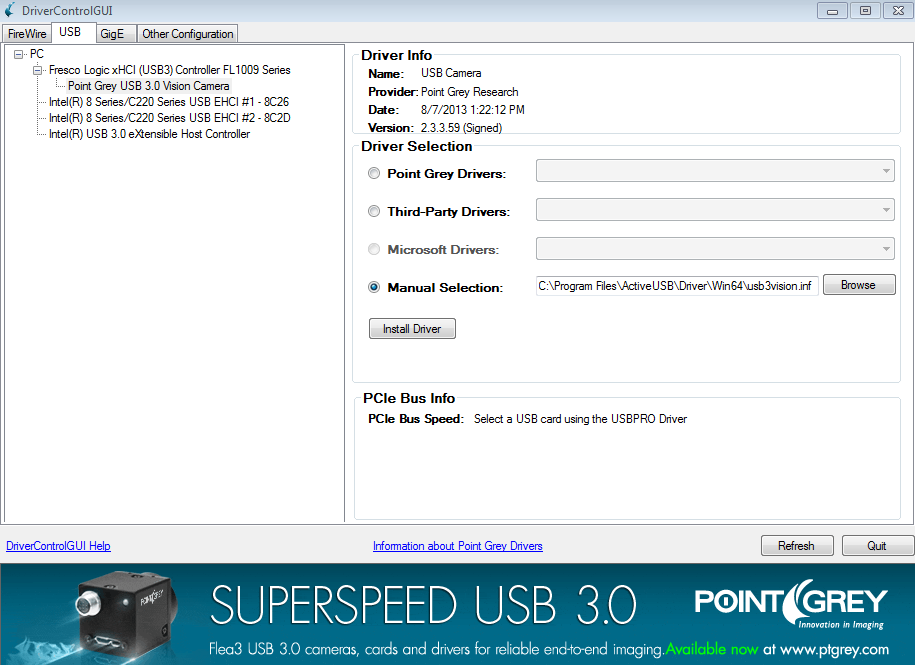
6. Click Install Driver.
Once you have installed the third-party USB3 Vision camera driver, the DriverControlGUI lists the camera under the third-party software listing.
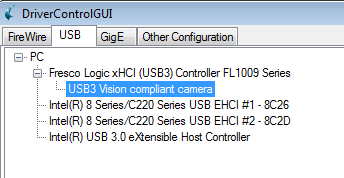
Third-party Camera Driver Installed
|
|
You can also use Windows Device Manager or DriverInstall.exe from A&B Software to install drivers on host controllers and cameras. |
Running Third-Party Software
USB3 Vision cameras work with the FlyCapture2 SDK, the Spinnaker SDK, or with third-party USB3 Vision applications.
|
|
This document provides examples using A&B Software’s ActiveUSB demo application. |
To access the camera in ActiveUSB:
1. Open UcamViewer.
Start menu→All Programs→ActiveUSB→UcamViewer
2. UcamViewer will start streaming live images from the camera
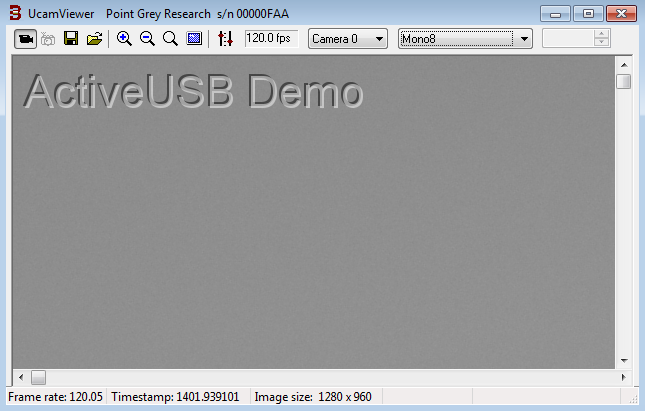
Configuring USB3 Vision Camera Properties
Configure USB3 Vision Camera Properties
To configure various camera properties:
1. Press the camera settings/USB3 properties icon in UcamViewer.

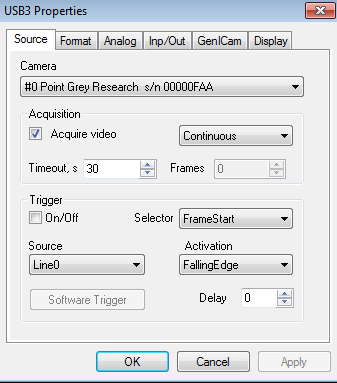
|
|
Ensure the camera has stopped streaming before applying camera settings. |
2. ActiveUSB provides different options to change camera properties via the source, format, analog, input/output, and display tab in the USB3 properties dialog.
3. Generic USB3 Vision properties can be configured via the “GenICam” tab.
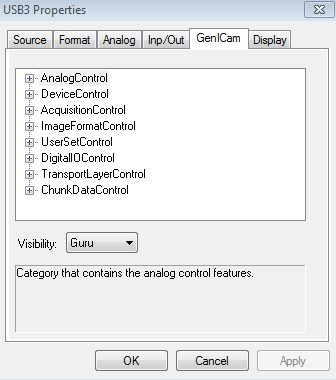
Capturing Images using Triggers
To capture images using triggers:
1. From the Source tab, check the On/Off box under Trigger section and select a trigger:
- Frame Start—the camera starts integration from the trigger defined by the Trigger Source and Trigger Activation and the integration time is defined by the Exposure Time value.
- Exposure Active—the camera starts integration from the Trigger Activation and the integration time is equal to the state time of the trigger input.
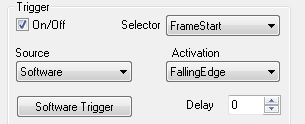
2. Set the Source to “Software”.
3. Click on the Software Trigger button.
USB 3.1 Chunk Data
Support for Chunk Data Stream is part of the USB3 Vision standard.
Chunk Data Stream allows images to have chunks of additional data such as time stamp or frame counter.
To enable Chunk Data Stream:
1. From the GenICam tab under USB3 Properties, expand the ChunkDataControl section.
2. Select ChunkEnable and turn it on.
3. Select ChunkModeActive and turn it on.
4. Select ChunkSelector to choose the desired data to include in the payload of the image.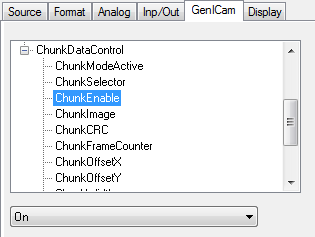
USB3 Vision Troubleshooting Tips
XML Cache
When the camera firmware is updated, the XML file may also be updated. The new file is detected automatically; however, in some cases, you may need to manually clear the XML cache. Once the old XML file is deleted, the third-party software downloads a new XML file from the camera.
To clear the XML cache:
1. Find the XML file in Windows.
For ActiveUSB the file is located at:
C:\Program Files\ActiveUSB\xmlcache
2. Delete the camera’s XML file.
Common USB 3.1 Issues
The following is a list of useful USB 3.1 knowledge base articles to help you troubleshoot common USB 3.1 issues.
- How does my USB 3.1 camera appear in Device Manager?
- My USB 3.1 camera does not achieve full frame rate
- Diagnosing USB 3.1 camera and bus errors
- Setting up multiple USB 3.1 cameras
- Using USB 3.1 and Linux
- Extending the working distance of USB 3.1 cameras
Known FlyCapture Issues with USB3 Vision Firmware
To use the FLIR USB3 Vision cameras, we recommend FlyCapture 2.5 SDK or later.
FlyCapture 2.4 SDK may work with USB3 Vision cameras, but FLIR has not done extensive testing with this pairing and cannot guarantee results.
FlyCapture 2.3 SDK and earlier versions do not work with USB3 Vision cameras.
What to do if…
My camera appears in FlyCapture2 but not in ActiveUSB?
- Ensure the camera has the correct firmware installed.
- Ensure the USB 3.1 host controller is using the manufacturer’s driver (or Windows 8 driver).
- Ensure the camera is configured to use the A&B device driver.


